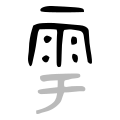Radical 173
| 雨 | ||
|---|---|---|
| ||
| 雨 (U+96E8) "rain" | ||
| Pronunciations | ||
| Pinyin: | yǔ | |
| Bopomofo: | ㄩˇ | |
| Wade–Giles: | yü3 | |
| Cantonese Yale: | yu5 | |
| Jyutping: | jyu5, jyu6 | |
| Japanese Kana: | ウ u (on'yomi) あめ ame (kun'yomi) | |
| Sino-Korean: | 우 u | |
| Hán-Việt: | vũ | |
| Names | ||
| Chinese name(s): | 雨字頭/雨字头 yǔzìtóu | |
| Japanese name(s): | 雨冠/あめかんむり amekanmuri[1][dead link] | |
| Hangul: | 비 bi | |
| Stroke order animation | ||
 | ||
Radical 173 or radical rain (雨部) meaning "rain" is one of the 9 Kangxi radicals (214 radicals in total) composed of 8 strokes. This radical character transforms into ⻗ when used as an upper component.
In the Kangxi Dictionary, there are 298 characters (out of 49,030) to be found under this radical.
雨 is also the 170th indexing component in the Table of Indexing Chinese Character Components predominantly adopted by Simplified Chinese dictionaries published in mainland China, with the component form ⻗ listed as its associated indexing component.
Evolution
[edit]-
Oracle bone script character
-
Bronze script character
-
Large seal script character
-
Small seal script character
Derived characters
[edit]| Strokes | Characters |
|---|---|
| +0 | 雨 |
| +3 | 雩 雪 雫 |
| +4 | 雬 雭 雮 雯 雰 雱 雲 雳SC (=靂) |
| +5 | 雴 雵 零 雷 雸 雹 雺 電 雼 雽 雾SC (=霧) |
| +6 | 雿 需 霁SC (=霽) |
| +7 | 霂 霃 霄 霅 霆 震 霈 霉SC (also SC form of 黴 -> 黑) 霊JP (=靈) |
| +8 | 霋 霌 霍 霎 霏 霐 霑 霒 (=𩃬) 霓 霔 霕 霖 霗 (=零) |
| +9 | 霘 霙 霚 (=霧) 霛 (=靈) 霜 霝 霞 霟 霠 |
| +10 | 霡SC (=霢) 霢 霣 霤 霥 |
| +11 | 霦 霧 霨 霩 霪 霫 霬 霭SC (=靄) |
| +12 | 霮 霯 霰 霱 露 霳 霴 |
| +13 | 霵 霶 霷 霸 霹 霺 (=溦 -> 水) 霻 |
| +14 | 霼 霽 霾 霿 靀 (=濛 -> 水) |
| +15 | 靁 (=雷) |
| +16 | 靂 靃 靄 靅 靆 靇 靈 |
| +17 | 靉 |
| +18 | 靊 |
| +19 | 靋 靌 (=寶 -> 宀) 靍 (=鶴 -> 鳥) 靎 |
| +21 | 靏 |
| +31 | 靐 |
Variant forms
[edit]This radical is printed and written differently in modern Traditional Chinese than in other languages. In Chinese as used in Mainland China (whether Simplified or Traditional) and Japanese, the four dots in the character are almost identical, while in modern standard Traditional Chinese as used in Taiwan and Hong Kong, the four dots point inwards to the center of the character, despite the former form is also widely used in Traditional Chinese publications.
| Japanese | Mainland China | Taiwan, Hong Kong |
|---|---|---|
| 雨 雲 | 雨 雲 | 雨 雲 |
- Handwritten forms
-
Independent character as used in Simplified Chinese and Japanese
-
Independent character as used in Traditional Chinese
-
Component form as used in Simplified Chinese and Japanese
-
Component form as used in Simplified Chinese and Japanese (alternative)
-
Component form as used in Traditional Chinese
Kanji
[edit]This character is one of the Kyōiku kanji or Kanji taught in elementary school in Japan.[2] It is a first grade kanji.[2]
Literature
[edit]- Fazzioli, Edoardo (1987). Chinese calligraphy : from pictograph to ideogram : the history of 214 essential Chinese/Japanese characters. calligraphy by Rebecca Hon Ko. New York: Abbeville Press. ISBN 0-89659-774-1.
References
[edit]- ^ "Kanji Box - Radicals list with names". Retrieved 2011-04-07.
- ^ a b "The Kyoiku Kanji (教育漢字) - Kanshudo". www.kanshudo.com. Archived from the original on March 24, 2022. Retrieved 2023-05-06.









